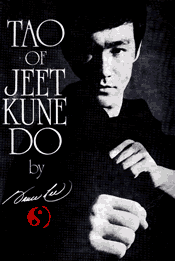
Tao
of Jeet Kune Do
Bruce Lee with Gilbert L. Johnson, Danny Inosanto and Linda Lee
In a special issue of Time Magazine for the Millenium, Bruce Lee was included as one of the most influential persons in the world. The author, who obviously knew nothing about Asia or Mr. Lee, threw every possible insult on his movies, ridiculed China's dismal 100 years and added that Mr. Lee was an arrogant egotist with a hanging testicle.
Five years later, China is now the center of the economic world and Bruce Lee is still worshipped by millions of fans and enthusiasts.
Although it is sad how commercialized and misunderstood Bruce Lee is, it is wonderful to bear witness to how many people he continues to influence and inspire. His early death probably contributed to his legend more than his movies (as did most authors and actors like James Dean and Yasunari Kawabata). That said, it is still a shame that so few people understand his beliefs and his way.
The Tao of Jeet Kune Do is not a book Bruce Lee would have approved of. It was a book published by Linda Lee and the self-promoting Gilbert L. Johnson after his death. If Mr. Lee had completed the work himself, The Tao of Jeet Kune Do would have been a classic in the level of Musashi Miyamoto's The Book of Five Circles. It is fully possible that little changes were made to the text by his wife and Mr. Johnson (who indexed and edited the material) but with Mr. Inosanto and his students (especially with his students), the accuracy of the book is put into question.
Bruce Lee is best known as a martial artist and an actor. However, he is not known for being a thinker. But this book shows he was. His obsession for fighting reached a sublime level. His thoughts were both contemporary and traditional. Bruce Lee's writing, if indeed left untouched by the book's editors, is intelligent and introspective. Mr. Lee's analysis of fighting reveal a sharp, organized and focused mind. Mr. Lee was obviously a serious thinker to have written so much about a topic that is almost an anachronism, especially in today's modern society.
Like the Hagakure, The Tao of Jeet Kune Do contains material that can be easily misinterpreted but at the same time carries many exceptional ideas that are unique and Mr. Lee's own -- both on fighting and living.
Unfortunately, due to Bruce Lee's immense popularity after his death, the Tao of Jeet Kune Do is a commercialized piece of work and cannot be called a classic the way Bushido and The Book of Five Circles are. The organization by Gilbert L. Johnson is doubtful. The acknowledgements, typed in small print to avoid notice, show that the book is not entirely Mr. Lee's own. Some of the text were taken or adapted from Boxing, Fencing, Fencing with the Foil, The Theory and Practice of Fencing. There is almost no way to find what was adapted from Bruce Lee's works or interpreted by the editors. The books that were published following Tao of Jeet Kune Do by Ohara Publications were also not sanctioned by Mr. Lee but by his wife. Although it carries pictures of Mr. Lee, the text is mostly an interpretation and poorly written making it more likely that it did not reflect Lee's ideas.
In the end, Bruce Lee's fears were realized. He did not want his work to be published because he felt they would be misunderstood or used in the wrong way. And so it has --- and many of the books about Bruce Lee are examples of this. Schools and imitations abound and the arts that Lee wanted to clarify became a commercial and empty tool.
The Tao of Jeet Kune Do continues to sell well (a top
seller in Amazon) but its authenticity
can easily be questioned -- it is more likely not the legacy Mr. Lee wished
to leave. Still, it cannot be denied that the Tao of Jeet Kune
Do is a work of genius and any serious student of the way should
read it. However, it should be read with caution and the reader must separate
what is truly Lee's and what is poor interpretation.
Rating:
![]()

Tao
of Jeet Kune Do
Bruce Lee with Gilbert L. Johnson, Danny Inosanto and Linda Lee
Ohara Publications (1975)
 |
 |
 |
 |
 |